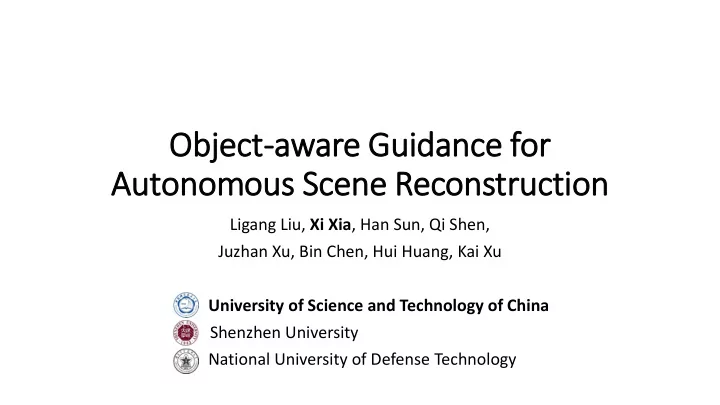

Ob Objec ect-aware G e Guidance e for Auton onom omou ous S Scene e Reconstruction on Ligang Liu, Xi Xia , Han Sun, Qi Shen, Juzhan Xu, Bin Chen, Hui Huang, Kai Xu University of Science and Technology of China Shenzhen University National University of Defense Technology
Background • Commodity RGB-D sensors Microsoft Kinect PrimeSense Intel RealSense
Background • RGB-D sensor allows real-time reconstruction KinectFusion [Izadi et al. 2011]
Background • Other real-time reconstruction methods Voxel Hashing ElasticFusion [Nießner et al. 2013] [Whelan et al. 2015]
Background • Indoor scene reconstruction -> 3D object models
Background • Human scanning is a laborious task [Kim et al. 2013] Time consuming Inaccurate scanning
Background • Modern robots are more and more reliable and controllable. Unimation, 1958 Fetch, 2015
Motivation Never feel Automatic tired Stable and accurate
Goal
Existing Works • High quality scanning and reconstruction of single object [Wu et al. 2014]
Existing Works • Global path planning and exploration [Xu et al. 2017]
Existing Works • Active reconstruction and segmentation [Xu et al. 2015]
Existing Works • Local view planning for recognition [Xu et al. 2016]
Conclusion of Existing Works • Two pass scene reconstruction and understanding. • Can only use low-level information in first exploration pass. First Pass Second Pass exploration & reconstruction segmentation & recognition [Xu et al. 2017] [Nan et al. 2012]
Conclusion of Existing Works • Two pass scene reconstruction and understanding. • Can only use low-level information in first exploration pass. First Pass Second Pass reconstruction & segmentation object recognition [Xu et al. 2015] [Xu et al. 2016]
The Main Challenge
Motivation • Human explore unknown scenes object by object !
Motivation • Human tend to scan object by object !
Our Solution • Key idea : Online recognized objects serve as an important guidance map for planning the robot scanning.
The Next Best Object Problem Which object should I scan next? Object of Interest (OOI)
Overview Objectness Based Segmentation Objectness Objectness Based Objectness Based Local View Planning Global Path Planning
Model-Driven Objectness • Objectness should measure both similarity and completeness
Partial Matching Query Dataset Model Dataset
Partial Matching Query Dataset Model 3DMatch [Zeng et al. 2016]
Partial Matching Query Dataset Model
Model-Driven Objectness
Model-Driven Objectness • Objectness should measure both similarity and completeness
Next Best Object Objectness Distance Orientation Size
Technical Challenge • How to segment and recognize objects during reconstruction? Missing data Recognition and segmentation constitute a chicken-egg problem
Pre-segmentation [Whelan et al. 2015] [Tateno et al. 2015] Pre-segmented Components Indoor object Scanned Model
Post-segmentation • Couples segmentation and recognition in the same optimization
Post-segmentation
Post-segmentation Results Pre-segmentation Post-segmentation
Dataset Construction
Dataset Construction Two advantages: Decrease the difference between CAD model and scanned model • Segmented components & component pairs can make retrieval easier •
The Next Best View Problem Which view of the OOI should I scan next? ? ? ? ?
Next Best View
System Pipeline Key techniques : Objectness based segmentation Objectness based reconstruction • • Pre-segmentation The next best object (NBO) • • Post-segmentation (important) The next best view (NBV) • •
Evaluation • Virtual scene dataset SUNCG (66 scenes) ScanNet (38 scenes)
Comparison • Comparing object recognition with PointNet++ [Qi et al. 2017]
Comparison • Comparing Rand Index of segmentation
Comparison • Comparing object coverage rate and quality against tensor field guided autoscanning [Xu et al. 2017] Depth noise
Comparison • Comparing object coverage rate and quality against tensor field guided autoscanning [Xu et al. 2017]
More Results
Limitations No similar models Cluttered scenes
Limitations & Future Works Single object Group structure
Future Works Combine image-based method Driverless car with LiDAR
Conclusion • An object-guided approach for autonomous scene exploration, reconstruction, and understanding • Model-driven objectness • Objectness-based segmentation • Objectness-based NBO strategy • Objectness-based NBV strategy • Coupled global exploration and local scanning • Coupled segmentation and recognition
Thank you! Q & A
Recommend
More recommend